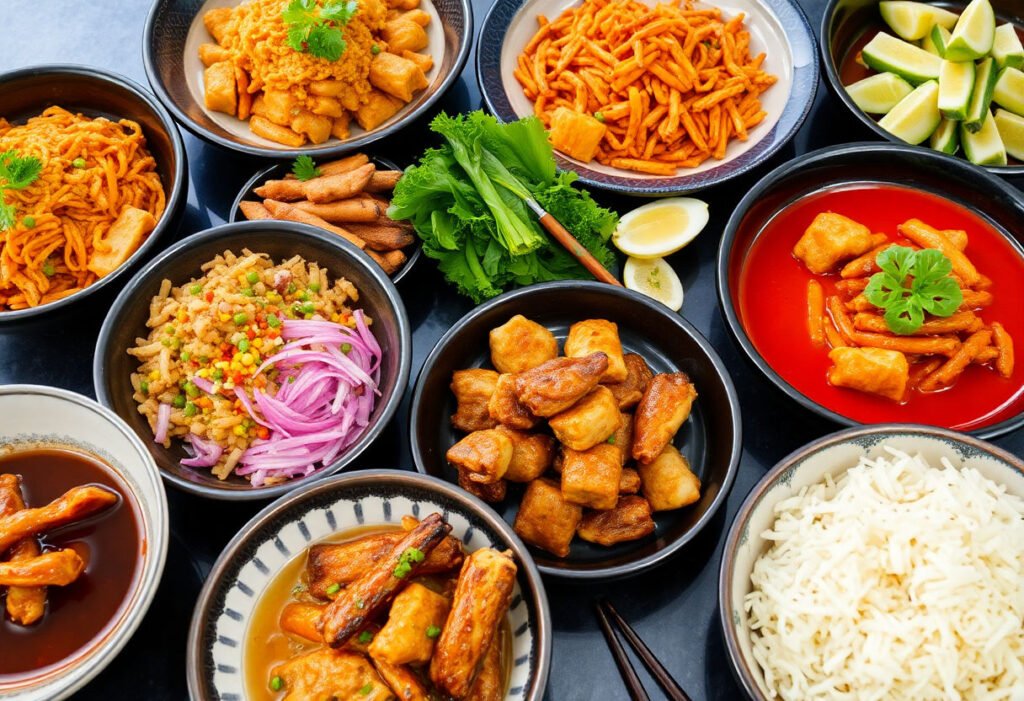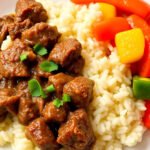Embarking on the journey of Asian meal prep offers a unique glimpse into a culinary tradition deeply rooted in precision and harmony. This article delves into the cultural significance of meal preparation throughout Asia, emphasizing its benefits, tools, and techniques. Readers will encounter a blend of traditional practices like fermentation and steaming, along with practical, quick recipes and storage methods suited for the modern lifestyle. For those seeking a balanced and diversified culinary experience, this guide provides invaluable insights into crafting healthy, flavor-rich dishes, encouraging the incorporation of Asian flavors into everyday meal planning.
Key Takeaways
- Asian meal prep offers a harmonious blend of efficiency and tradition, promoting both nutritional balance and cultural richness.
- Essential tools and staple ingredients are fundamental to mastering Asian cooking techniques like fermentation, steaming, and stir-frying.
- Strategic meal prep planning ensures efficient scheduling and portioning, making it easier to integrate into a busy lifestyle.
- Quick and easy recipes facilitate the preparation of meals in advance, keeping dining experiences fresh and diverse.
- Effective preservation and storage techniques are vital for maintaining flavor and quality, allowing prepped meals to be safely consumed later.
The Importance of Meal Prep in Asian Cuisine
Meal prep has long been a cornerstone in Asian cuisine, rooted deeply in both cultural traditions and practical necessity. This practice extends far beyond mere culinary preparation; it is an integral aspect of daily life that speaks to the values of balance, efficiency, and sustainability. In many Asian cultures, meal prep is not just about preparing food in advance but is an art form that reflects harmony and mindfulness.
One of the primary benefits of meal prep in Asian cuisine is the ability to maintain nutritional balance. Dishes are often crafted with a mindful blend of proteins, carbohydrates, and the vibrant colors of vegetables, ensuring a diet that is not only flavorful but also healthful. This approach resonates with the ancient philosophy of yin and yang, where maintaining balance translates to well-being.
Additionally, meal prep in Asian cultures emphasizes sustainability and resourcefulness. Many traditional recipes call for ingredients that are readily available and have a long shelf life, such as rice, soy products, and various dried goods. This not only reduces waste but also allows for the effective use of leftovers, creating a cycle of use that is both economical and considerate of the environment.
Moreover, Asian meal prep often involves time-tested techniques such as fermentation and pickling. These methods not only enhance flavors but also extend the shelf life of ingredients, further demonstrating the foresight and ingenuity embedded in this culinary tradition.
In the fast-paced modern world, adopting these practices offers a way to bring tradition into the contemporary kitchen, providing nourishment for both the body and soul while honoring heritage.
Essential Tools and Ingredients
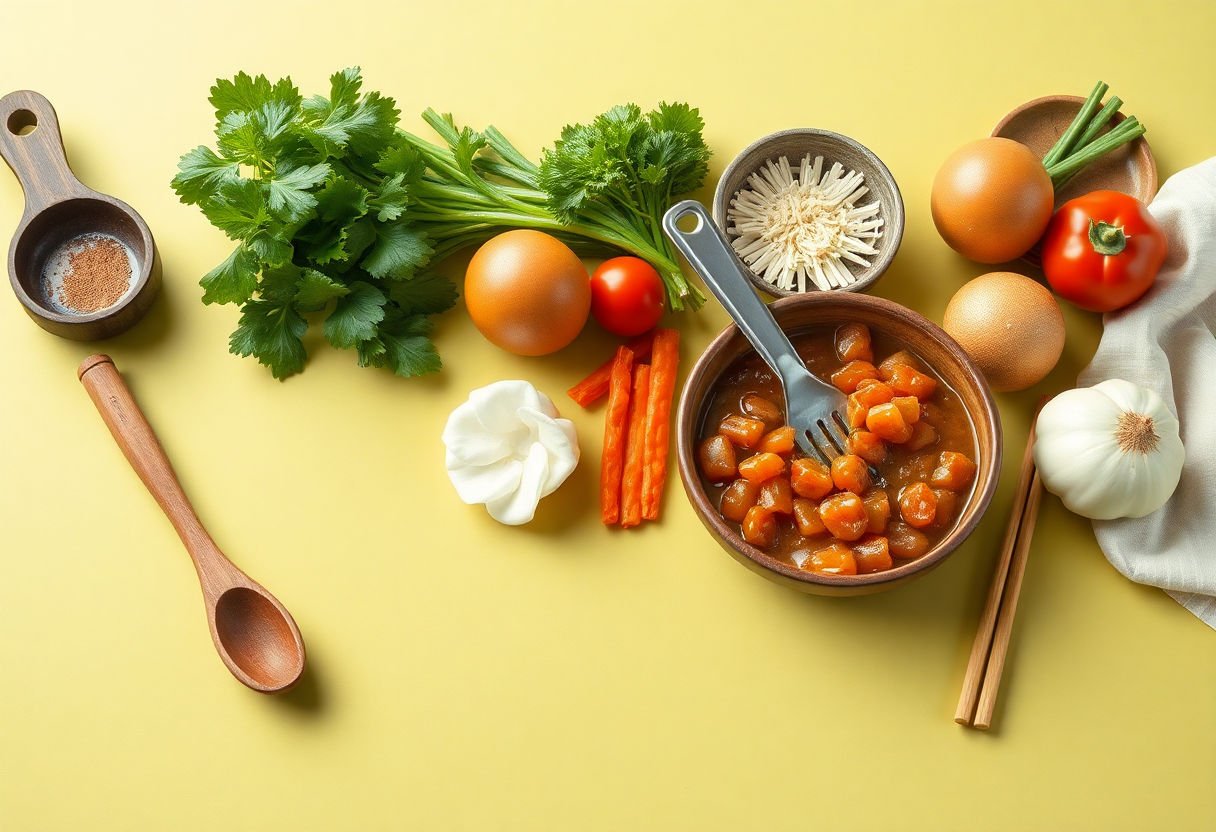
Acquiring the right tools and ingredients is crucial for adept Asian meal prep. Begin with the essentials that will transform your kitchen into a hub of culinary efficiency.
Essential Kitchen Tools
- Wok: A quintessential tool in Asian kitchens, the wok’s versatile nature allows for stir-frying, deep frying, and steaming.
- Rice Cooker: Perfect rice cooking is a cornerstone of many Asian meals; a rice cooker simplifies this task.
- Steamer Basket: Vital for preparing dumplings or steaming vegetables, retaining their nutrients.
- Chef’s Knife: Opt for a high-quality chef’s knife or a traditional Chinese cleaver for chopping and slicing.
- Mandoline Slicer: Provides uniform cuts for vegetables, which is essential for dishes like stir-fries.
Must-Have Ingredients
- Rice and Noodles: Staples such as white rice, jasmine rice, and a variety of noodles are foundational.
- Soy Sauce and Fish Sauce: Soy sauce adds a salty richness, while fish sauce offers a unique umami flavor.
- Garlic and Ginger: Fresh garlic and ginger are fundamental aromatics found in countless recipes.
- Oils: Sesame oil for its distinct flavor and peanut oil for high-heat cooking.
- Spices and Seasonings: Ensure a stock of five-spice powder, star anise, and Szechuan peppercorns for authentic tastes.
These tools and ingredients form the backbone of effective Asian meal prep, enabling you to explore diverse techniques and create dishes rich in tradition and taste. Embrace this fusion of practicality and tradition to enhance your culinary journey.
Meal Prep Planning
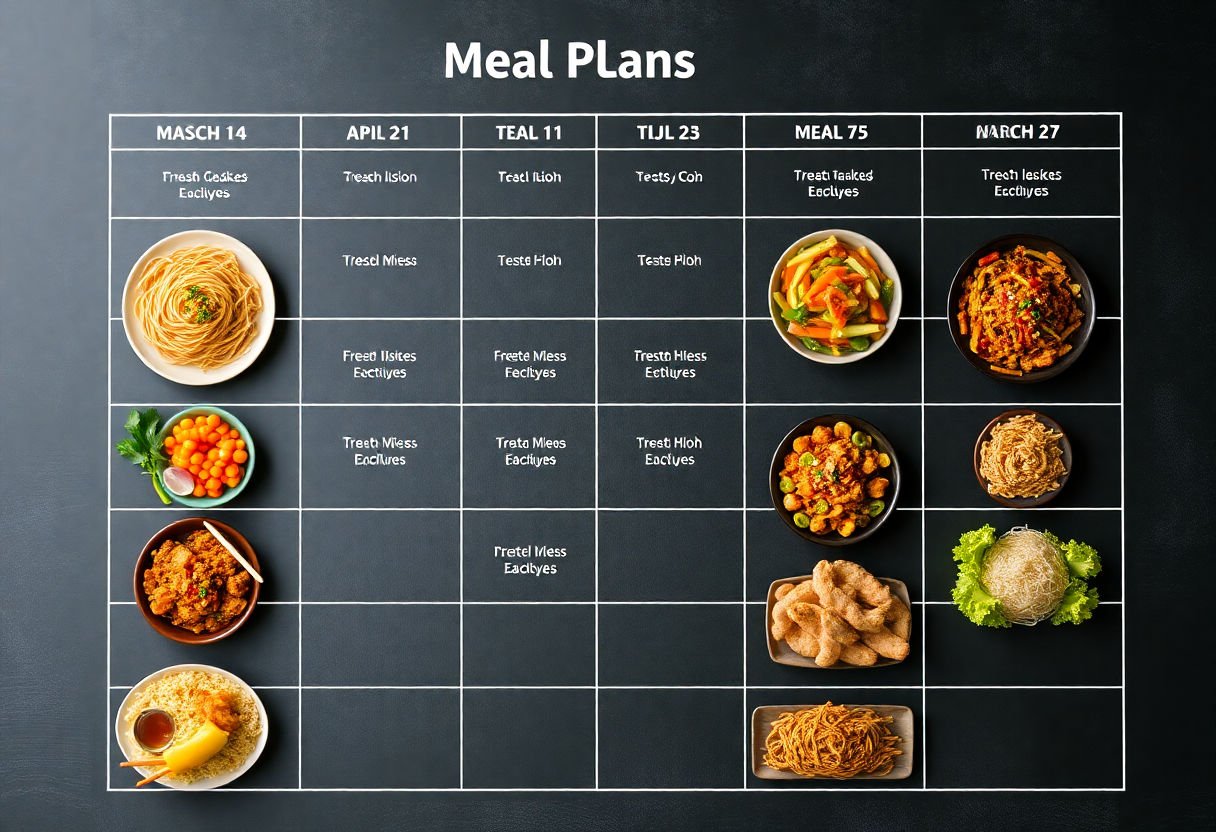
Creating a successful Asian meal prep plan involves a combination of strategy and efficiency to ensure a smooth and enjoyable cooking experience. To begin, start by setting aside time each week dedicated solely to planning and preparing your meals. This could be a weekend afternoon or any time that fits into your schedule consistently. Consistency is key to making meal prep a seamless part of your routine.
Next, consider the following steps:
-
Menu Planning: Decide on the dishes you want to prepare. Integrating a variety of flavors and cuisines, ranging from Japanese sushi rolls to Thai curries, keeps your meals exciting. Aim for a balance of proteins, vegetables, and carbohydrates in each meal.
-
List Making: Create a detailed shopping list for all the ingredients you’ll need. Include staple items like soy sauce, ginger, garlic, and rice to ensure you have essentials on hand.
-
Batch Cooking: Prepare large quantities of grains such as rice or quinoa and proteins like chicken, tofu, or beef. These can be used as the base for multiple meals throughout the week. Portion these into containers soon after cooking to maintain freshness.
-
Portion Control: Use uniform containers to help manage portion sizes effectively. It’s beneficial to invest in a set of quality airtight containers that help in preserving freshness and make storage more effective.
-
Incorporate Fresh Produce: Focus on using seasonal vegetables, as they are not only fresher and more nutritious but also often more affordable. Freshness in ingredients enhances the flavor profile of your meals significantly.
By incorporating these steps into your meal prep routine, you’ll save time during the week and enjoy a variety of delicious Asian-inspired meals.
Traditional Asian Meal Prep Techniques
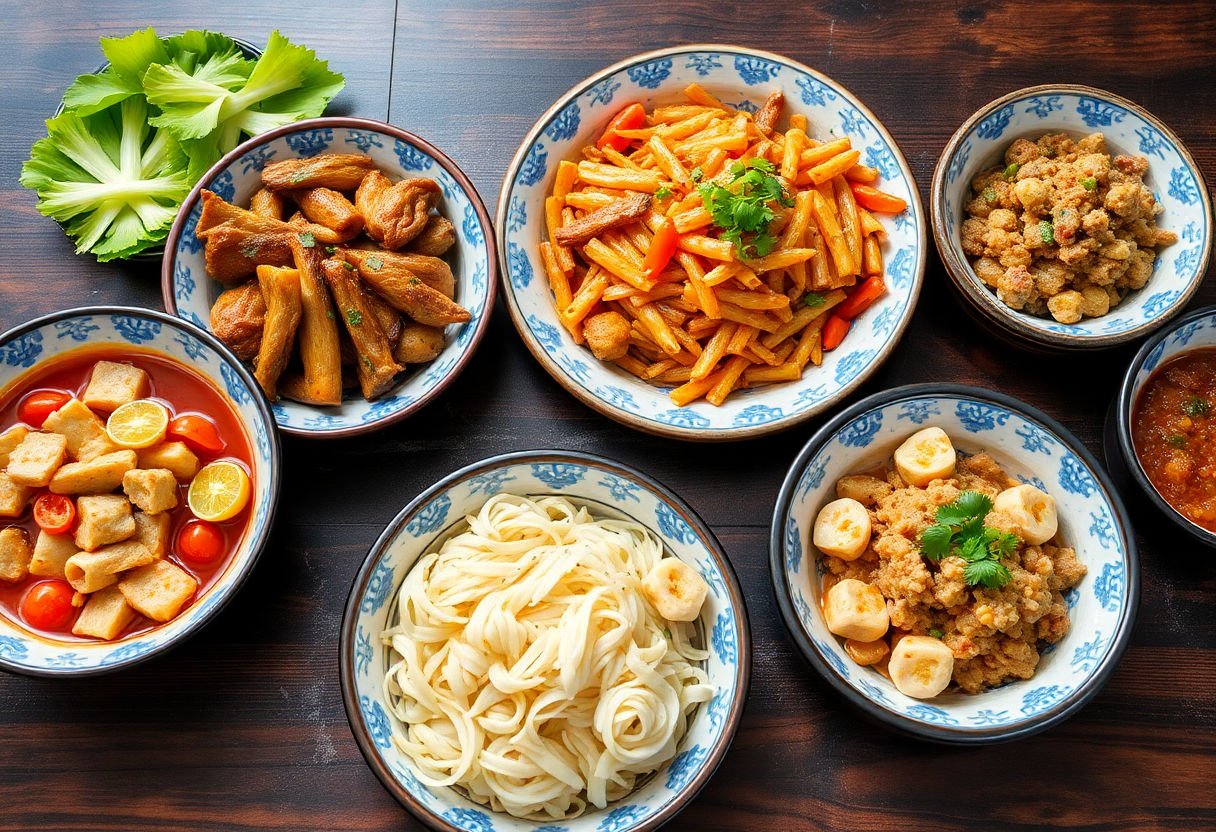
Asian meal prep is deeply rooted in techniques that have been refined over centuries. Among these, fermentation stands out not only as a method of preservation but also as an enhancer of flavor and nutritional value. Foods like miso in Japan or kimchi in Korea are staples in Asian cuisines, transformed through the fermentation process to offer probiotic benefits.
Steaming is another traditional technique, treasured for its ability to cook food quickly while preserving its natural flavors and nutrients. It’s commonly used for preparing dishes like dim sum, fish, and an assortment of vegetables. Its popularity lies in its simplicity and effectiveness in maintaining a dish’s vibrant colors and textures.
Stir-frying, renowned for its efficiency, captures the essence of many Asian kitchens. This method involves cooking ingredients at high heat in a minimal amount of oil, resulting in crisp vegetables and tender meats. The speed of stir-frying not only seals in flavors but also aligns with busy lifestyles, making it a preferred technique for meal preppers.
Incorporating these traditional methods into modern meal prep practices offers a spectrum of benefits, from enhanced taste profiles to health improvements. As more people seek to eat healthily without compromising on flavor, these techniques provide a foundation for creating wholesome, appetizing meals. Whether it’s the complex layers of flavors achieved through fermentation, the gentle care of steaming, or the dynamic flair of stir-frying, traditional Asian meal prep techniques continue to inspire culinary creativity and innovation in today’s kitchens.
Quick and Easy Asian Meal Prep Recipes
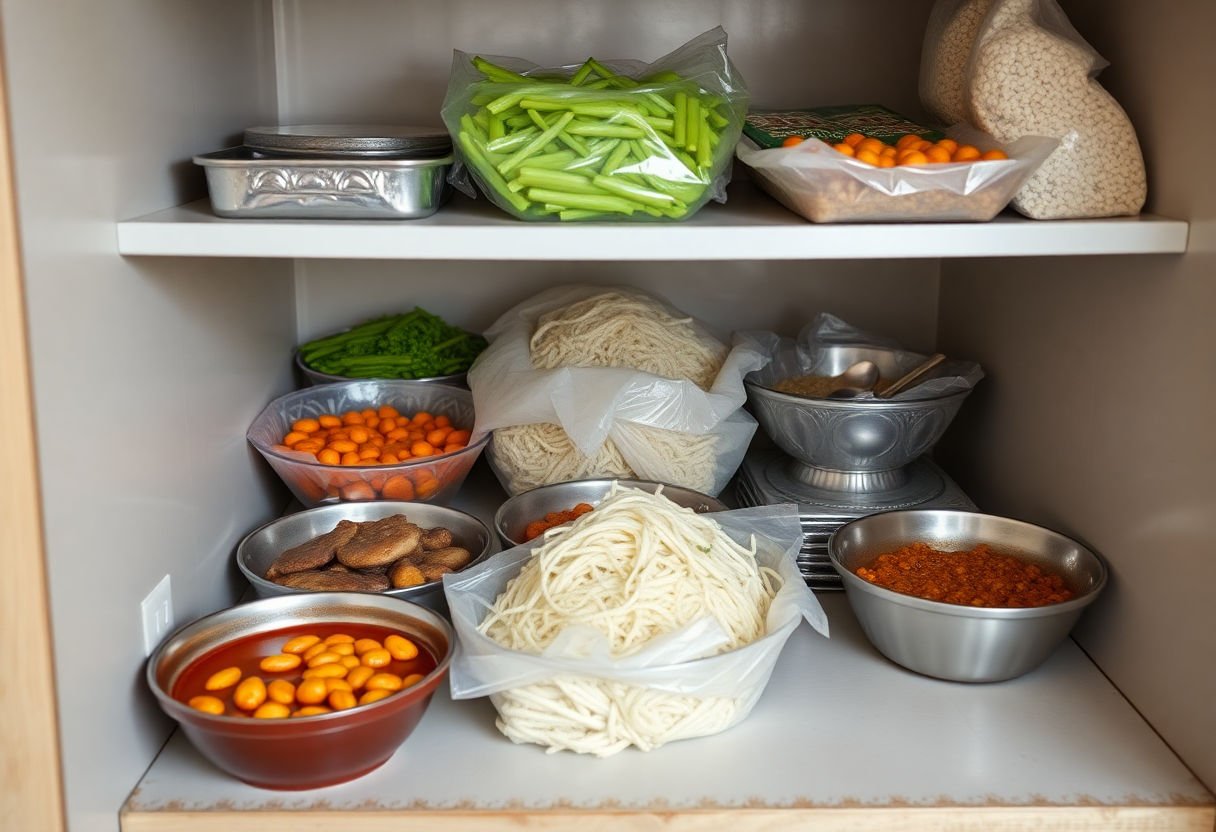
When it comes to preparing meals efficiently without compromising on flavor, Asian cuisine offers a myriad of quick and easy meal prep recipes that even the most time-constrained individuals can enjoy. These recipes are designed to be prepared in advance, allowing you to relish delectable dishes throughout the week with minimal effort.
One popular option is Teriyaki Chicken Bowl, which combines succulent chicken marinated in a savory-sweet teriyaki sauce with steamed rice and fresh vegetables. The chicken can be cooked in batches and stored with individual servings of rice and vegetables, making it easy to grab and go.
Another simple yet flavorful dish is Stir-Fried Tofu with Vegetables. Utilizing firm tofu sautéed with a mélange of vibrant, crunchy vegetables like bell peppers, broccoli, and snap peas, this vegetarian delight is both nutrient-dense and satisfying. A light sauce composed of soy sauce, ginger, and garlic enhances the flavors, making it a meal that’s both delicious and wholesome.
For a warm, comforting option, consider preparing Miso Soup with Seaweed and Tofu. Rich in umami, this soup can be stored in jars, ready to be reheated for a quick weekday lunch or dinner. By incorporating seaweed and tofu, the soup remains not only healthy but also rich in essential minerals and proteins.
These Asian meal prep recipes are perfect for maintaining a balanced diet while saving time in the kitchen. By focusing on dishes that combine convenience and nutritional density, you ensure that your meal preparations are not only quick but also aligned with your dietary goals.
Healthy and Balanced Asian Meals
Creating a healthy and balanced Asian meal involves a thoughtful blend of fresh ingredients and traditional cooking methods, ensuring not only flavor but nutritional value. Asian meals often use colorful vegetables, lean proteins, and an array of herbs and spices, which naturally support a balanced diet.
Balanced Meal Components:
-
Protein: Lean meats such as chicken or pork, tofu, tempeh, and seafood are common protein sources. These proteins are commonly grilled, steamed, or stir-fried to retain nutrients while minimizing added fats.
-
Whole Grains: Integrating whole grains like brown rice or quinoa instead of white rice or noodles can boost fiber intake, supporting digestion and sustained energy.
-
Vegetables: A variety of vegetables are used, often chosen for their seasonality and nutritional content. Vegetables like bok choy, bell peppers, broccoli, and carrots add both vitamins and minerals.
-
Healthy Fats: Asian cuisine incorporates healthy fats from ingredients like sesame seeds and oils, nuts, and avocados, offering essential fatty acids beneficial for heart health.
Nutritional Balancing Tips:
-
Portion Control: Allocate half of your meal to vegetables, a quarter to proteins, and the remaining quarter to grains. This proportion ensures a well-rounded intake of essential nutrients.
-
Minimize Processed Ingredients: Use fresh ingredients wherever possible, avoiding premade sauces that may include added sugars or sodium.
-
Herbal Infusions: Season your meals with herbs like cilantro, basil, or lemongrass, which can add rich flavors while offering antioxidants and anti-inflammatory benefits.
Achieving a balanced diet through Asian meal prep focuses on variety and the use of whole, unprocessed foods, which can enhance overall well-being.
Preserving and Storing Asian Meals
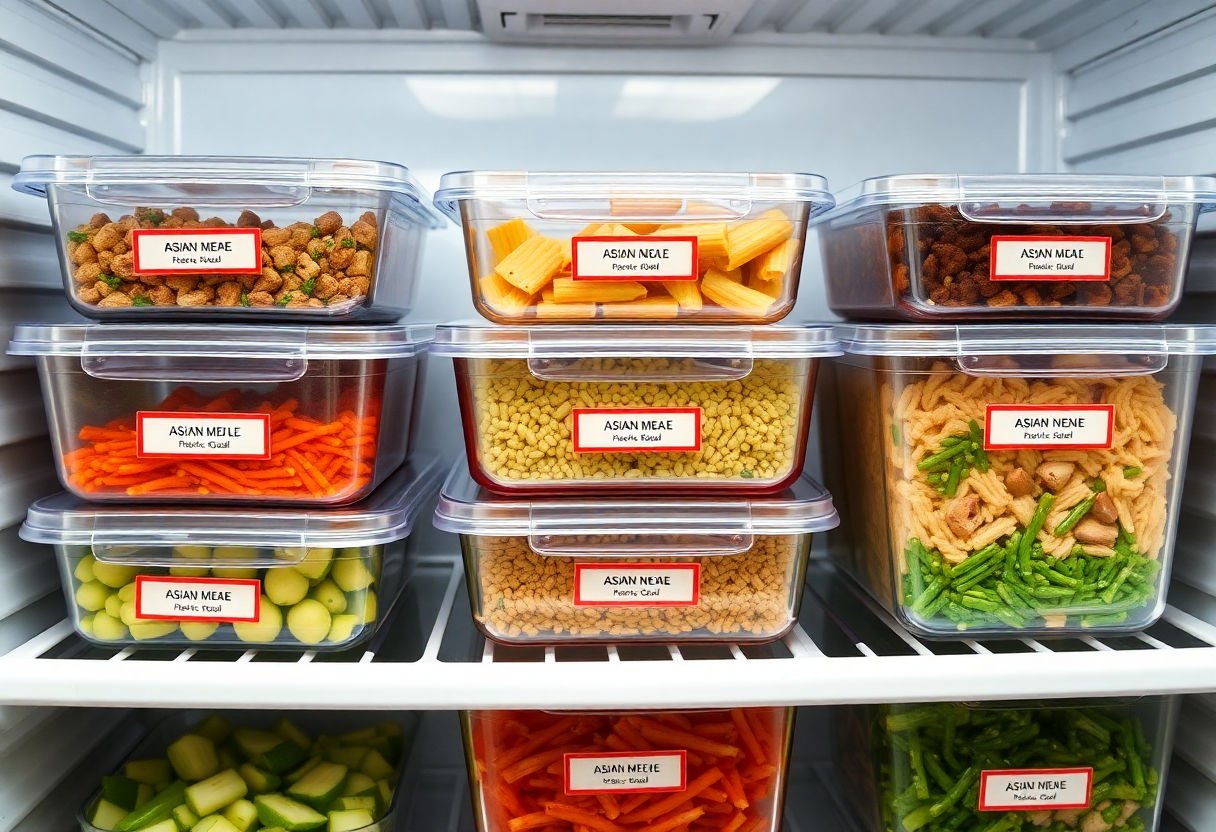
Preserving and storing Asian meals effectively is crucial to maintaining their unique flavors and nutritional value. When done properly, your carefully prepared Asian dishes can be enjoyed even on your busiest days without compromising quality.
Freezing Asian Meals: Freezing is an excellent method for long-term storage of Asian meals. To ensure freshness, place foods in airtight containers, removing as much air as possible to prevent freezer burn. For dishes like dumplings or stir-fries, consider flash-freezing them in a single layer on a baking sheet before transferring them to containers or freezer bags. This prevents them from sticking together.
Refrigeration Techniques: For short-term storage, refrigeration is key. Make sure your meals are cooled to room temperature before placing them in the refrigerator to prevent moisture build-up, which can degrade the texture and taste. Seal meals in airtight containers, and label them with the date of storage. Consume refrigerated meals within 3-4 days to enjoy optimal freshness.
Reheating Practices: Proper reheating is essential to preserve the integrity of Asian flavors and textures. For rice and noodle-based dishes, add a splash of water before heating to prevent them from drying out. Utilize a steamer to reheat dumplings and other delicate foods to maintain their moisture and consistency. Always ensure meals are reheated to an internal temperature of at least 165°F for food safety.
By following these best practices, you can savor the intricate flavors of Asian cuisine even when relying on prepped meals.
Incorporating Variety in Asian Meal Prep
Incorporating variety into Asian meal prep is not only a matter of taste but also enhances the nutritional content of your meals. Diversity in flavors and ingredients is a cornerstone of Asian cuisine, offering a delightful depth and range that can be seamlessly integrated into meal prep routines. By rotating grains like rice, quinoa, or soba noodles, you can change the base of your meals while maintaining a healthful approach.
Consider utilizing an array of spices and condiments to introduce different flavor profiles. Soy sauce, ginger, garlic, lemongrass, and gochujang are excellent examples of ingredients that can bring distinctive tastes to various dishes. Integrating such elements will ensure your meals stay exciting and flavorful.
Enhance your meal prep with a mix of protein sources such as tofu, chicken, fish, shrimp, or tempeh. This approach not only accommodates different dietary preferences but also ensures a balance of essential nutrients. Exploring methods such as grilling, baking, or steaming can alter the texture and experience of these proteins, making each meal preparation unique.
Don’t forget the importance of seasonal vegetables. By selecting fresh produce like bok choy, bell peppers, or snap peas, you can add vibrant colors and crunch to your dishes, elevating both the look and taste. A weekly visit to your local farmer’s market can serve as an inspiration for the week’s meal prep.
Finally, introducing regional specialties such as Thai curry, Japanese sushi rice, or Korean kimchi stew not only enriches your meal plans but also deepens your appreciation for the vast culinary landscape of Asian cuisines. Through careful selection and an adventurous spirit, your Asian meal prep can become more varied and enjoyable.
Conclusion
Embarking on the journey of Asian meal prep not only enhances your culinary skills but also brings significant benefits such as efficiency and nutritional balance. By embracing traditional techniques like fermentation and steaming, while ensuring a diverse range of flavors, you can transform your meal planning routine into an art form. As you apply these techniques, you’ll discover a deeper appreciation for the wholesome and vibrant aspects of Asian cuisine. Let the wisdom of Asian meal prep guide you in creating meals that are not only delicious but also aligned with your wellness goals.
Frequently Asked Questions
What makes Asian meal prep unique compared to other cuisines?
Asian meal prep emphasizes balance and diversity, incorporating a wide array of flavors and textures into each meal. Traditional techniques like steaming, fermentation, and stir-frying also play a crucial role in maintaining essential nutrients while enhancing taste.
Can I substitute some of the ingredients in Asian recipes?
Yes, many Asian recipes are flexible and can accommodate substitutes. For example, you can use tamari instead of soy sauce or swap tofu for meat in certain dishes to meet dietary preferences or restrictions.
How long can prepped Asian meals be stored?
Prepped Asian meals can typically be stored for up to three to five days in the refrigerator. If frozen, they can last for several months, but it is important to follow proper storage techniques to maintain freshness and flavor.
What are some essential tools for Asian meal prep?
Essential tools for Asian meal prep include a good-quality wok, a rice cooker, and sharp kitchen knives. These tools help streamline the preparation process and ensure authentic cooking methods are employed.
Is it possible to meal prep traditional fermented Asian foods?
Yes, fermenting foods like kimchi or miso can be incorporated into a meal prep routine. They are often made in large batches and stored for extended periods, adding both flavor and nutritional benefits to your meals.
